Mexico City and Teotihuacán
Our first perception of Mexico City, commonly known as D.F. (Distrito Federal), was somewhat blurred by a massive downpour. After sunny skies in L.A. and a resplendent drive through the Big Sur, howling rain and drenched streets greeted us as soon as we left the airport. We had already been introduced to the meteorological state of affairs, courtesy of our plane’s pilot, who gave warning of a turbulent landing. A tad melodramatic, we thought, since we’ve had worse.
Our feet safely grounded in the D.F., we proceeded to our hostel, hidden in a remote intersection of the bustling city. Since we only had to deal with some bureaucratic matters (yes, I’m actually a spy), and would soon be on our way to meet friends in San Andrés Cholula, we took the inclement weather with a dose of serene resignation. What this meant was that we would not be visiting any of the tourist sights – why risk pneumonia when there would be so much to see later on?
From our first day in Mexico, two experiences stand out:
1. Think the Paris or NYC metros are busy? Ah, blissful ignorance… We took the metro during rush hour, at approximately 7 am. The ride is cheap (3 MXN = 0.17 EUR), easier and faster than taking a taxi through the chaotic D.F. roads, but also insanely crowded. As we approached the platform, we saw multitudes almost falling into the tracks. It was like seeing a leviathan swaying by a precipice, muscles tense but undulating. The first wave managed to fight their way into the metro doors, becoming one with the rest of the tightly packed sardines. We rushed forward and stuck to our spot, trying to appear taller. By the time the next carriage stopped and spat out some of its human entrails, we were already surrounded by a throng of impatient natives, bidding their time.
In the end, it was a remarkably straightforward procedure. We simply became part of the wave, Elle being actually lifted from the ground, and let ourselves be guided into a compact space where a fly would have trouble buzzing. As the metro stations passed by in quick succession, we eventually had our faces unstuck from a stranger’s armpit and began the organic process of oxygen renewal, or breathing as us commoners call it.
Being accustomed to beggars in the metro, we were taken aback by the stunning range of peddlers walking in and out of the subway. Young and old, they sold everything from toothpaste to chocolate to CDs with Western or Mexican hits to nail clippers to editions of the Penal Code (I kid you not). Some kids selling CDs had actual speakers attached to their backs, booming their way into the different carriages.
2. After the metro, we took our first tour of the Taxi world. Taking a taxi in a foreign land, or anywhere really, is always a daunting experience. The fears of being ripped off, kidnapped, insulted or made ashamed of thinking such things by a ridiculously kindhearted taxi driver are always present. We soon learned there were two types of taxis in the D.F.: the ones with and without a taximeter. The first were seen speeding in the middle of traffic and were white-colored; the latter were usually idling by the sidewalks and wore brown. The place we needed to get to was apparently remote by their standards, thus ensuring we had our probably first instance of a taxi driver refusing to take us somewhere simply because he couldn’t be bothered. One taxi driver soon became fifteen, until we invoked the skills of the cheetah and hunted down a taxi with a taximeter willing to take us where we wanted to go.
Following a week of ultimate relaxation in San Andrés Cholula, we returned to the D.F. with anxious hearts. However, this time the weather was kind to us, the inclement rain being replaced by a beautiful azure sky, lending the city a new and more welcoming shine. We were now also prepared to tackle the transit system in all its shapes and forms, since we had to return to the bureaucratic hellhole we had visited earlier.
Thus we embarked on the sequel to “Tourists in Mexico: WDF!” Having learned the tricks of the trade, everything went much smoother. The metro was now a breeze, we hailed a friendly taxi driver on our second attempt and even got acquainted with the bus system.
Confident in our newly acquired street smarts, we paid a visit to the Zócalo, one of the biggest city squares in the world and one of the most identifiable images of the D.F. It’s biggest and perhaps most impressive monument, apart from the gigantic Mexican flag in the middle of the plaza, is the old Cathedral, or Metropolitan Cathedral of the Assumption of Mary of Mexico City, as nobody ever says.
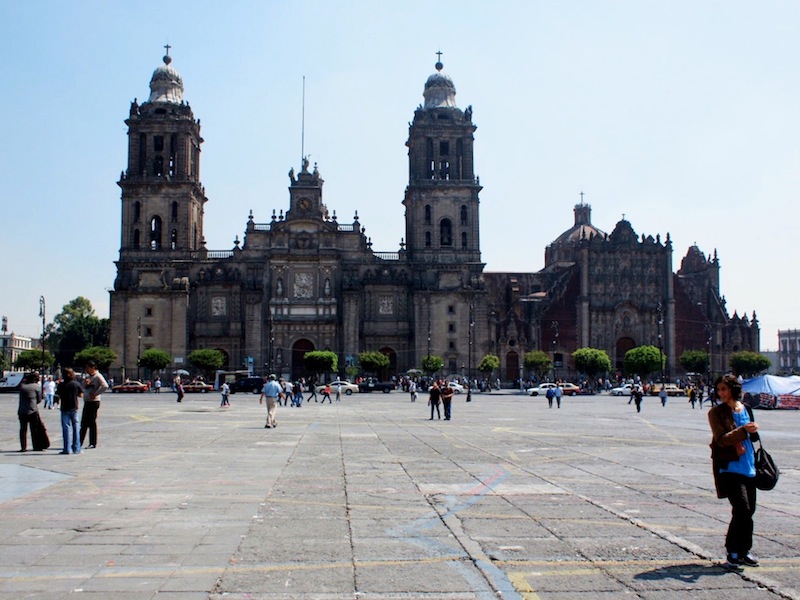
The Zócalo in Mexico City
Although an imposing presence, it is also a reminder of the Spanish conquest of Tenochtitlán, a bloody and unscrupulous affair which saw the ancient Aztec capital razed to the ground. What little remains of the old temples can be seen close to the Zócalo, languishing beneath the unforgiving weight of History.
Even if Tenochtitlán is no more, we spent an afternoon meandering the magnificent site of Teotihuacán, located an hour away from the D.F. We took the bus from the Autobuses del Norte station, which is easily accessible by metro. The ride cost us 40 MXN (2.3 EUR) each, one way.
We arrived at the site’s southern entrance in the early hours of the afternoon, under the gaze of scattered puffy clouds. After buying our tickets for the wonderfully modest amount of 57 MXN (3.3 EUR) each and passing by the usual vendors lining an archeological site’s entrance, we came upon the Avenue of the Dead, stretching for 2 km in the direction of the Pyramid of the Moon.
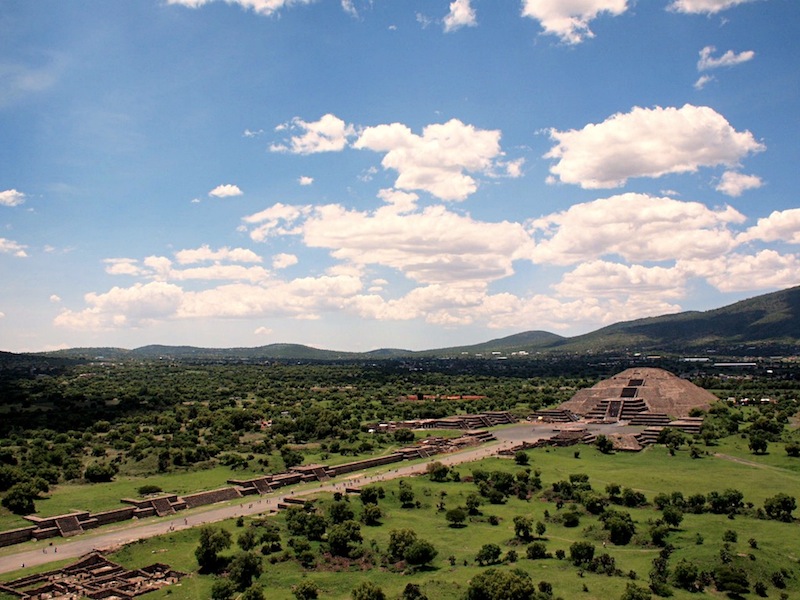
Avenue of the Dead and Pyramid of the Moon, seen from atop the Pyramid of the Sun
Already we were blown away and we had barely begun our visit… In front of us stood the Citadel, a large plaza so named by the Spanish who stumbled upon the holy city in 1520. The extensive square houses the Temple of Quetzalcoatl, topped with the Feathered Serpent Pyramid, inside of which archeologists discovered hundreds of buried skeletons.
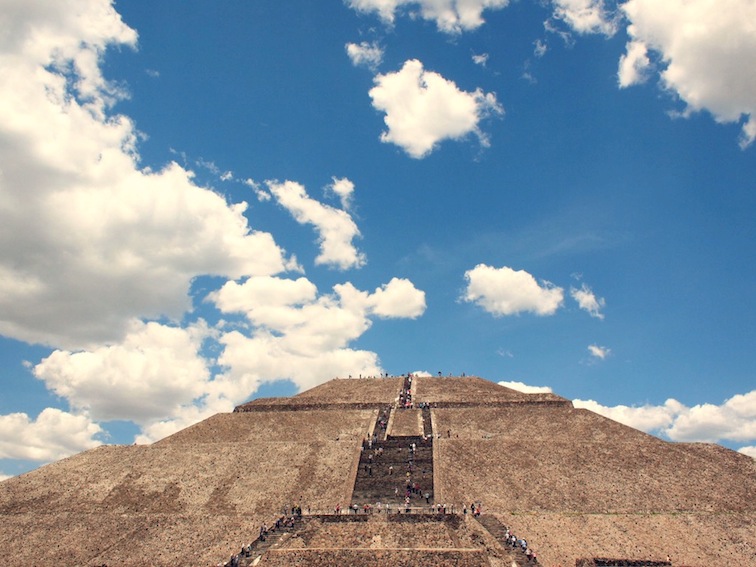
Pyramid of the Sun
Continuing north through the Avenue of the Dead, we approached the magnificent Pyramid of the Sun, a massive stone structure dotted with tourists climbing its vertiginous steps. It stands as the third-largest pyramid in the world, after the Great Pyramid of Cholula and the Great Pyramid of Cheops in Egypt. Walking by various salesmen peddling whistles, bottled water, jewelry and knickknacks we eventually faced the intimidating task of climbing the Pyramid of the Sun.
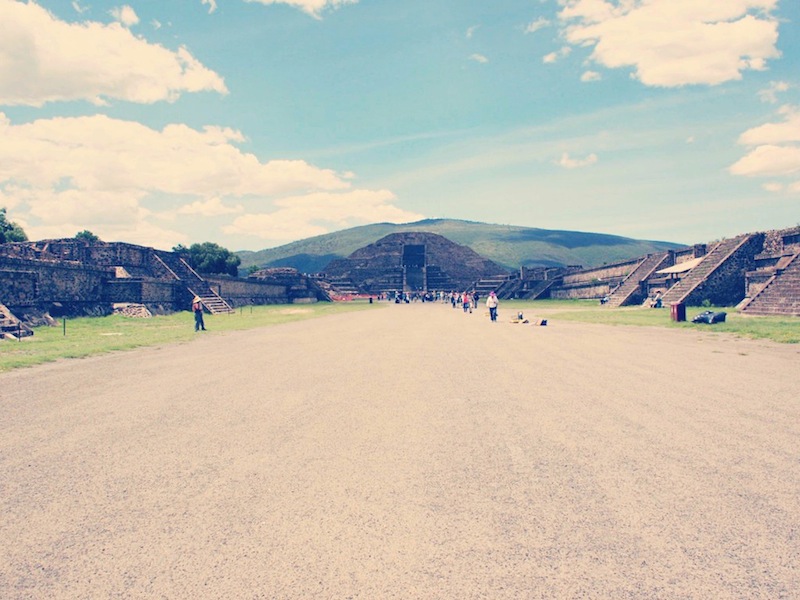
Pyramid of the Moon from Avenue of the Dead
Following a few sweaty minutes of perilous equilibrium, we reached the top, only to be greeted by a stunning view of the whole complex, constructed in compliance with astronomical alignments. The Pyramid itself, whose construction started around 100 BC, is built according to the position of the Sun at its zenith.
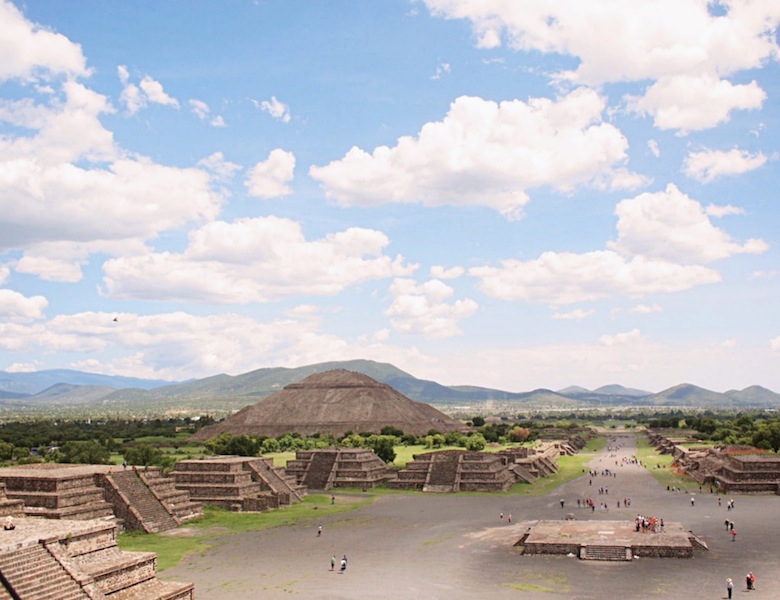
Avenue of the Dead and Pyramid of the Sun, seen from atop the Pyramid of the Moon
It is remarkable to think we were only seeing 10% of the total surface of the great ancient city, which is thought to have stretched out over 36 km2. Teotihuacán’s rise occurred at the same time as the flourishing of classical Rome, but at the height of its glory, around 500 AD, Teotihuacán was larger than Rome itself, both in terms of size and population.
We were left enthralled by the cosmic harmony of Teotihuacán, and as we climbed with shaking legs the steps of the Pyramid of the Moon, we had a glimpse of what the Aztecs must have felt when they chanced upon the city around 1320, and thought it was the place where the gods had been created.
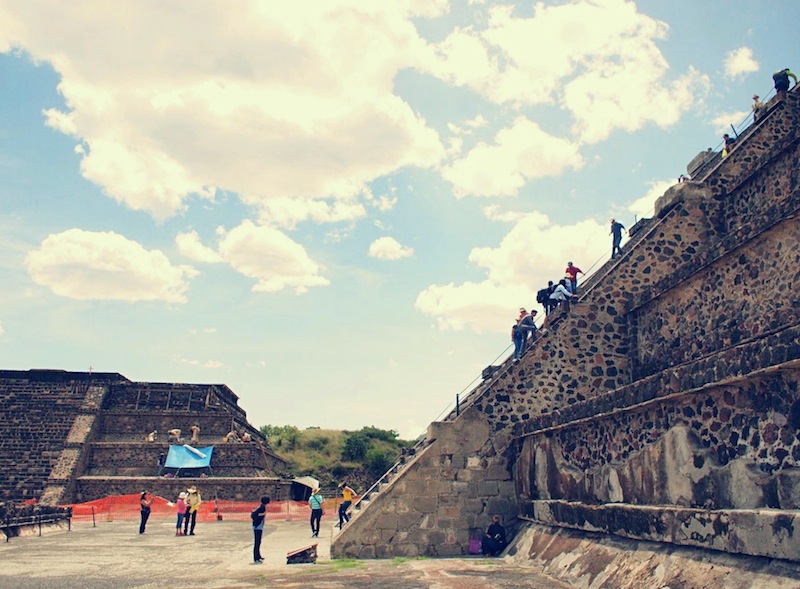
Elle ready to climb the Pyramid of the Moon
Like other awe-inspiring capitals of powerful empires, such as Angkor Wat in Cambodia or Sigiriya in Sri Lanka, Teotihuacán eventually suffered an abrupt decline, becoming nearly obliterated by fire and consequently abandoned during the 7th century. Today, it still retains a wondrous mystique, and one can find in its prodigious design a stirring portal into an enigmatic past, where people lived and breathed in thrall of plumed serpents, flayed gods and the chilling roar of the jaguar.


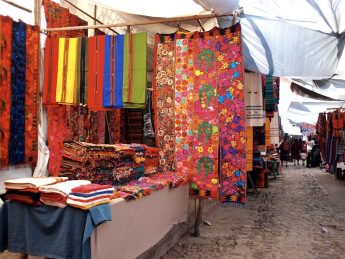
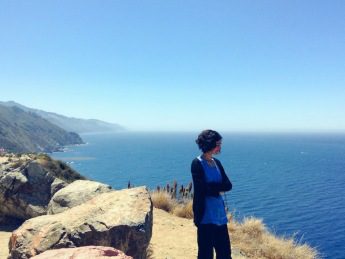
I have just read some of your posts of México and i find them quite accurate and beautifully written. As a mexican living in México City I would be delighted to introduce you to some deeper aspects of our beautifull country whenever you wish to come.
Hope to hear from you,
Santiago.
Gracias, Santiago! If ever back in your wonderful country we’ll be in touch. Good luck!
I always wanted to visit teotihuacan. I’ve been obsessed with the Mayan and atzec culture since a little child but never really made it to middle america. Which really makes no sense cuz i litterally traveled the world. But whenever i try to plan it something goes wrong. so for the time being i gotta be content with reading reports about these amazing places from people like you. Thanks for the share.
How long did it take to tour the site?
Hey Norman! I can definitely relate to what you’re saying. For instance, we’ve been trying to get to South America for years now, but something always comes up that prevents us from doing so. Guess we all need to live vicariously at some point or other 🙂 We visited Teotihuacán in the afternoon. It took us around 4 hours to meander the site and climb a couple of pyramids. It all depends on your speed and your interests. Hope you make it there some day! Good luck!